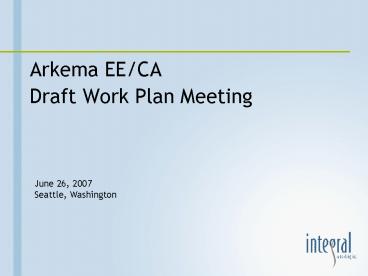Arkema EECA - PowerPoint PPT Presentation
1 / 38
Title: Arkema EECA
1
- Arkema EE/CA
- Draft Work Plan Meeting
June 26, 2007 Seattle, Washington
2
Outline
- Mass Removal Approach
- Why Mass Removal ?
- What constitutes Mass Removal ?
- How do we benefit from Mass Removal?
- Where does Mass Removal fit into the PH RI/FS ?
- General Comments on EPA revised EE/CA Work Plan
3
Why a Mass Removal Approach?
- Significantly reduces risk
- Risk decreases with decrease in contaminant
mass/concentration - Remediates most significant mass in sediment
associated with Arkemas former operation - Highly effective
- Proven technology
- Consistent with NTCRA Guidance and LWG RI/FS
- Recommended by EPA team members
- Precedence
- Greens Bayou, Fox River, Grasse River, Great Lakes
4
Why a Mass Removal Approach? (cont.)
- Public support
- Majority DDx mass in discrete area
- Addresses other Portland Harbor COIs
- Consistent with EPAs iterative, adaptive
management approach - Engineering-based removal action
- Consensus approach expedites project
5
What is the Mass Approach?
- Compile 230 data points
- All sediment data
- Establish model domain
- Convert from mg/kg to mass per unit volume
- Perform 3D kriging with C-Tech EVS Software
- Calculate volumes with ArcGIS
6
Still of Grid Etc
7
(No Transcript)
8
(No Transcript)
9
(No Transcript)
10
What is the Mass Approach? (cont)
- Establish isovolumes to identify the distribution
of DDx in sediments - Approx. 1000, 100, 10, 5, 1, 0.1 and 0.035 mg/kg
(EPAs stated objective 0.035 mg/kg DDx SLV
x1000) - Calculate total mass per concentration level
11
EVS Model Plan View
12
EVS Model View to NW
13
EVS Model View to N
14
(No Transcript)
15
(No Transcript)
16
(No Transcript)
17
(No Transcript)
18
(No Transcript)
19
(No Transcript)
20
(No Transcript)
21
(No Transcript)
22
(No Transcript)
23
(No Transcript)
24
What is the Mass Approach? (cont.)
- Calculate preliminary dredge volumes per each
isovolume contour - Calculate Total DDx mass removed per volume
dredged - Compare Total DDx mass versus volume
- Estimate different mass removal scenarios
- Establish breakpoint between mass of DDx and
sediment volume
25
Dredge Prism Calculations
26
1,000 mg/kg 7 DDx Mass 3,500 cu yds
100 mg/kg 56 DDx Mass 19,000 cu yds
10 mg/kg 89 DDx Mass 73,000 cu yds
5 mg/kg 92 DDx Mass 110,000 cu yds
1 mg/kg 96 DDx Mass 280,000 cu yds
0.1 mg/kg 99.7 DDx Mass 830,000 cu yds
0.035 mg/kg 100 DDx Mass 1,300,000 cu yds
27
1,000 mg/kg 7 DDx Mass 3,500 cu yds
100 mg/kg 56 DDx Mass 19,000 cu yds
10 mg/kg 89 DDx Mass 73,000 cu yds
5 mg/kg 92 DDx Mass 110,000 cu yds
1 mg/kg 96 DDx Mass 280,000 cu yds
0.1 mg/kg 99.7 DDx Mass 830,000 cu yds
0.035 mg/kg 100 DDx Mass 1,300,000 cu yds
28
(No Transcript)
29
(No Transcript)
30
Dredge Volume v. Mass Removal
31
Break Point Graph
32
1,000 x SLV Total DDx - Surface
33
1,000 x SLV Total DDx - Subsurface
34
1,000 x SLV All COIs - Surface
35
1,000 x SLV All COIs - Subsurface
36
How Do We Benefit from Mass Removal?
- Significantly reduces DDx mass
- Significantly reduces associated risk
- Expedites removal action
- Measures effectiveness
- Frees up resources
- Meets RAOs
- Meets 11 principles
- Meets guidance
- Public support
- Residual risk addressed by RI/FS
- Resolves dispute
37
Where does Mass Removal fit into the Portland
Harbor RI/FS ?
- Remediates Arkema DDx hotspot
- Compatible with PH RI/FS and RA
- The NTCRA is one of a series of response actions
where a completed RI will be available - Advances the goal of the Superfund Accelerated
Clean Up Model to include substantial,
prioritized risk reduction - An integral part of an adaptive-management
approach at a contaminated sediment megasite
where dredging is the preferred alternative
38































